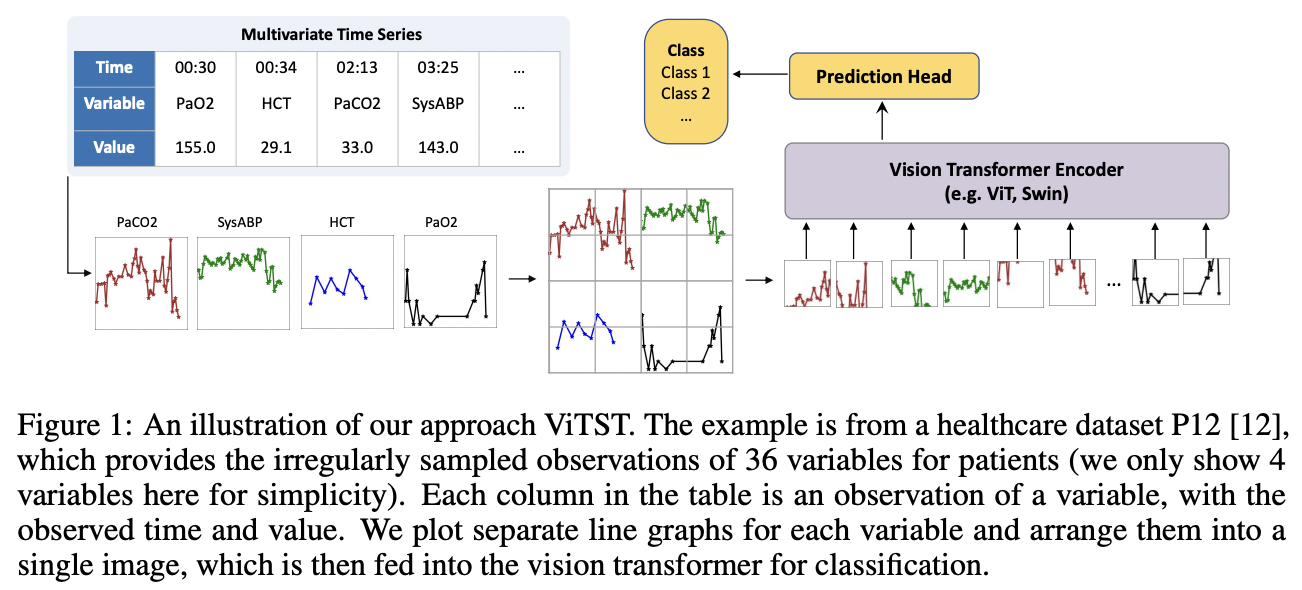Time Series as Images: Vision Transformer for Irregularly Sampled Time Series
Contents
Abstract
Irregular sampled time series (= ITS)
- Complex dynamics
- Pronounced sparsity
ViTST
- Idea) Convert ITS $\rightarrow$ line graph images
- Model) Pretrained ViT
- Task) TS classification
- Potential to serve as a universal framework for TS modeling
- Experiments
- SoTA on healthcare and human activity datasets
- e.g., leave-sensors-out setting
- where a portion of variables is omitted during testing
- e.g., leave-sensors-out setting
- Strong at missing observations
- SoTA on healthcare and human activity datasets
- Code) https://github.com/Leezekun/ViTST
1. Introduction
Research Question
Can these powerful pre-trained vision transformers capture temporal patterns in visualized time series data, similar to how humans do?
Proposal: ViTST (Vision Time Series Transformer)
- (1) IMTS to line graph
- Into a standard RGB image
- (2) Finetune a pre-trained vViT

Line graphs
- Effective and efficient visualization technique for TS
- Capture crucial patterns
- e.g., temporal dynamics (represented within individual line graphs)
- e.g., interrelations between variables (throughout separate graphs)
Experiments
- Superior performance over SoTA designed for ITS
- Exceeded prior SoTA
- Dataset = P19 & P12
- (AUROC) 2.2% & 0.7%
- (AUPRC) 1.3% & 2.9%
- Dataset = PAM (human activity)
- (Acc, Precision, Recall, F1) 7.3%, 6.3%, 6.2%, 6.7%
- Dataset = P19 & P12
- Srong robustness to missing observations
Contributions
- Simple yet highly effective approach for IMTS classification
- Excellent results on both irregular and regular TS
- Successful transfer of knowledge from pretrained ViT to TS
2. Related Works
(1) Irregularly sampled time series
Definition) Sequence of observations with varying time intervals
- IMTS: Different variables within the 2 same time series may not align
Common approach
- Convert continuous-time observations into fixed time intervals
a) Non-attention based
- (1) GRU-D: Decays the hidden states based on gated recurrent units (GRU)
- (2) Multi-directional RNN: Capture the inter- and intra-steam patterns
b) Attention based
- ATTAIN: Attention + LSTM to model time irregularity
- SeFT: Maps the ITS into a set of observations based on differentiable set functions
- mTAND: Learns continuous-time embeddings
- With a multi-time attention mechanism
- UTDE: Integrates embeddings from mTAND and classical imputed TS with learnable gates
- Raindrop: Models irregularly sampled time series as graphs
- Utilizes GNN
(2) Imaging time series
- Gramian fields [39], recurring plots [14, 37], and Markov transition fields [40]
- Typically employ CNNs
- Limitation: Often require domain expertise
3. Approach
(1) Overview
a) Two steps
- Step 1) Transforming IMTS to line graph
- Step 2) Employ pre-trained ViT as an image classifier
b) Two components
- (1) Function that transforms the time series $\mathcal{S}_i$ into an image $\mathrm{x}_i$
- (2) Image classifier that takes the line graph image $\mathrm{x}_i$ as input and predicts the label $\hat{y}_i$.
c) Notation
$\mathcal{D}=\left{\left(\mathcal{S}_i, y_i\right) \mid i=1, \cdots, N\right}$: TS dataset with $N$ samples
-
(y) $y_i \in{1, \cdots, C}$, where $C$ is the number of classes.
-
(X) $\mathcal{S}_i$ consists of observations of $D$ variables at most
( = some might have no observations)
Format: $\left[\left(t_1^d, v_1^d\right),\left(t_2^d, v_2^d\right), \cdots,\left(t_{n_d}^d, v_{n_d}^d\right)\right]$
- Observations for each variable $d$ are given by a sequence of tuples with observed time and value
IMTS = Intervals between observation times $\left[t_1^d, t_2^d, \cdots, t_{n_d}^d\right]$ are different across variables or samples
(1) “TS to Image” Transformation
a) Time series line graph
Line graph
- Prevalent method for visualizing temporal data points
- Each point = Observation marked by its time and value
- Horizontal axis = Timestamps
- Vertical axis = Values
